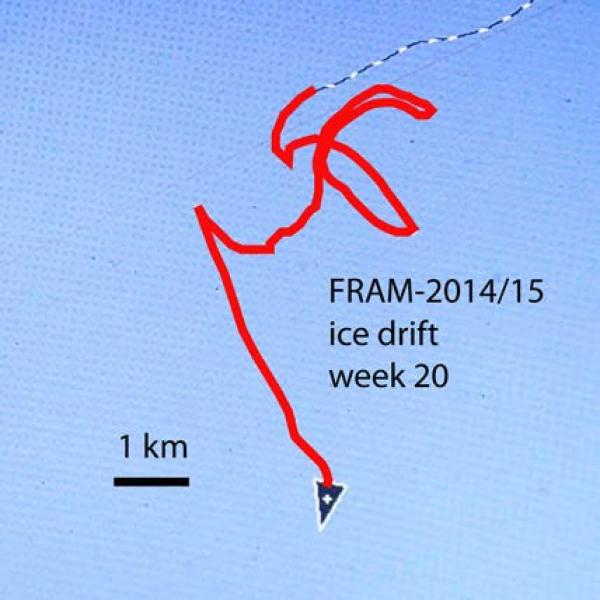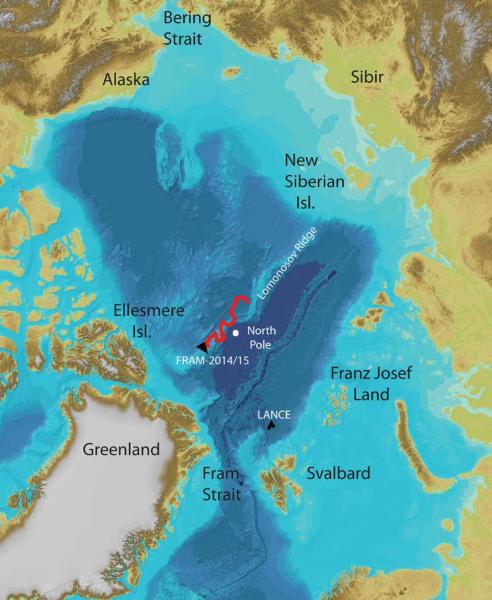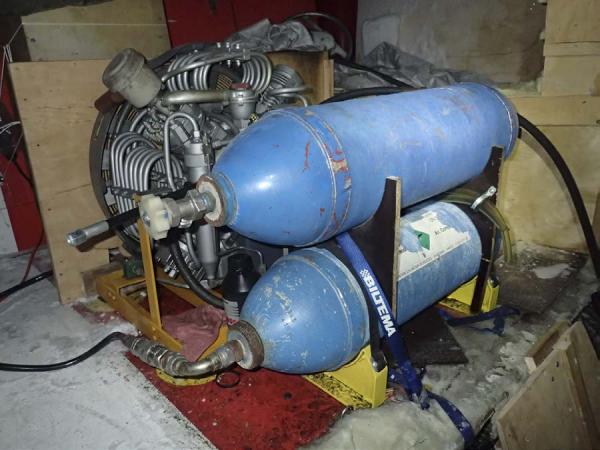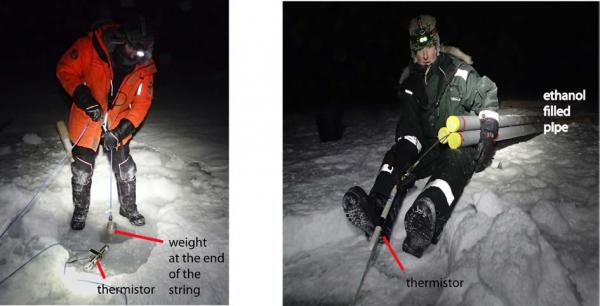
(12 - 19 Jan. 2015)
Ice drift
The ice camp moved only 8 nautical miles (15 km) during the week. Most of the motion was back and forth within an area of 1.5 nautical miles (Figs. 1 and 2). The drift was extremely slow Wednesday through Saturday even though the wind speed reached 17 knots on Saturday. The surface air pressure field has been dominated by an elongated high between Beaufort Sea and the East Siberian Sea throughout the week with a high pressure ridge extending from there towards the North Pole, Wednesday through Saturday. Winds were less than 5 knots until Thursday and > 10 knots during the last part of the week.
This week included another very special event in the High Arctic with the arrival of LANCE of the Norwegian Polar Institute at 83° 15' N, 21° 32' E, northeast of Svalbard (Fig. 2). This is the starting point for an ice drift with an extensive program to study processes within the young ice. See the web site: www.npolar.no/en/expedition-field/n-ice2015,

Fig. 1. The drift track (red) of FRAM-2014/15 during week 20 (12-19 January, 2015).
Sea ice dynamics
An ice floe is a relatively flat area surrounded by recently active pressure ridges or open leads. The interior of a floe may contain older subdued pressure ridges, but no open cracks. The floe where our camp is located, is bounded 200 meters to the north by a pressure ridge with an open lead behind it. The lead is now closing, but no consequences have so far been felt in the camp. The lack of overview of the area and ice activity around us in the dark, is frustrating. The recent crack mentioned in the last report has been inactive. We have made reconnaissance trips to the old disrupted camp area and there are no signs of recent ice activity.

Fig. 2. Overview of current drift ice stations present in the Arctic Ocean.
Camp life
Temperatures this week have been ranging between -25° C and -35° C until Saturday afternoon. From then on it went below -40° C. The week has been dominated by two issues; the slow drift, on the average 500 meters a day and the break-down of our generators. We started out with two identical new 4.5 kW diesel generators and now both are down for the same fatal reason; one valve rod on both is unseated and the adjustment screw on the valve rocker arm broken. Metal pieces came out when the oil was drained. One generator had over 3.000 hours and the other 2 hours. The loss is very inconvenient, but will not hamper our continued operation. We have a small 800 Watt generator, but it does not seem to hold any load. We also started out with two 1 kW wind mills as back-up. One wind mill got buried by ice blocks during the last camp break-up and our effort to recover it failed. The other got submerged by overwater on the ice and is still not tested. Our ultimate back-up for charging of batteries is a 90 W fuel cell which consumes 1.5 liter of ethanol a day. The daily supply of electric power is provided by the 440 horsepower hovercraft engine which have to run for twenty minutes every two hours. During idling, it consumes 3 liter/hour. So far, the engine has started instantly in temperatures below -40° C even in cases where it has not been operation for at least 24 hours. Our AC power comes from an inverter which change 28 volt DC into 230 volt AC with a maximum load of 500 watts.
In practical terms, the loss of the generators means; no melting of snow by electric heating (i.e. no showers), no use of the electrical oven for cooking, no electric heat on the compressor (Fig. 3) and hydraulic oil reservoir, no use of the heat gun and no outside lightening. The most inconvenient issue is loss of heat on the compressor, but this will be compensated by a diesel fired stove.

Fig. 3 The compressor (240 liters/min) and air bottles (40 liter) for supply of air to the air gun mounted on the port deck of the hovercraft.
Science
During the week, the following suite of continuous measurements has been operating:
Bathymetry and sub-bottom profiling:
- four active autonomous echo sounder buoys reporting to shore via Iridium
- continuous seismic reflection measurements ( until Wednesday morning))
Oceanography:
- two Aanderaa current meters at 800 and 1050 meter depth, respectively.
Atmosphere:
- measurement of incoming and outgoing radiation from the ice surface
- surface infrared skin temperature
- sun time
- Aanderaa weather station
The seismic data acquisition continued until Wednesday morning. We moved only a kilometer over the top of Lomonosov Ridge on the Makarov Basin side from Sunday night until Wednesday morning.
Audun finished resetting the 30 thermistor probes and the 300 meter long string was redeployed on Thursday (Fig. 4).

Fig. 4. Deploying the 300 meter long thermistor string
Audun also discovered fresh tracks of a polar fox. This individual came up from our down-wind side and just passed through our camp. The animal did not dwell with anything in particular and probably got scared from human presence - a behavior which is very different from our previous visiting fox four weeks ago. We think two separate individuals are involved.
Life in the High Arctic is treating us well.
Yngve Kristoffersen & Audun Tholfsen
Daily reports
Monday 12 January.
Position: 87° 22.8' N, 63° 52' W, temperature - 25° C, air pressure 999 hPa, wind 3 knots from the ESE. Ice drift 0.1 knots towards W. Shooting seismic reflection all day. Audun was occupied with restarting the data loggers for the thermistor string. Checked the radiation flux instruments. Data logger battery is 12.9V, large battery for ventilator is 14.3 V. Cleaned all sensors and also the weather station sensors. A lead, about 200 meter to the north of the camp has been present since we came to this site 1.5 months ago. The lead is now closing
Tuesday 13 January.
Position: 87° 23.4' N, 63° 57' W, temperature - 32° C, air pressure 1009 hPa, wind 3 knots from the NE. Ice drift 0.1 knots due south. Acquiring seismic reflection data all day. At 2200 hours, the generator suddenly stopped. The cause was loss of compression. Adjustment screw on valve rocker arm broken and valve lifting rod unseated - metal parts came out when the oil was drained. We had two identical 4.5 kW diesel generators and now both are down with the same fatal fault. One generator had over 3.000 hours and the spare only 2 hours before break-down.
Wednesday 14 January
Position: 87° 22.5' N, 63° 47' W, temperature - 30° C, air pressure 1019 hPa, wind 1 knot from the SSW. Ice drift 0.0 knots. Acquiring seismic reflection data until 0815 hours as we were out of air from loss of heat on the compressor. Started work on the generator to see if there was any hope of repair. The engine has to be opened from the generator side and the generator axle is pressed on to the engine drive shaft so special tools would be needed. Further pursuit of repair was considered futile. Audun made a hole for deployment of the thermistor string. The hole is to be lined with three plastic core liners bundled together and partly filled with ethanol. This will make recovery easy and avoid the fishing operation to catch the top of the string.
Thursday 15 January 2015
Position: 87° 22.3' N, 63° 46' W, temperature - 24° C, air pressure 1021 hPa, wind 5 knots from the south. Ice drift 0.0 knot. Deployed the thermistor string about 70 meters from the hovercraft. Took down the old generator shack and started to make preparations for rebuilding the heat box for the compressor. Heating would now be by a diesel stove. Fresh tracks of a polar fox were spotted by Audun.
Friday 16 January.
Position: 87° 22.1' N, 63° 51' W, temperature - 33° C, air pressure 1022 hPa, wind 12 knots from the east. Ice drift 0.1 towards NNW. We started the small 800 W generator and run it for three hours. Went down to the old camp area, dug out one drum of gasoline and pulled it to the new camp. Checked the radiation flux instruments and cleaned all sensors. Run the small generator again, but it is unable to handle the load from charging the hovercraft batteries. The generator engine runs, but power is lost. This means we are permanently out of 230 V power, except what can be derived from a 500 Watt, 28 Volt DC to 230 Volt AC inverter. In practical terms it means; no melting of snow by electric heating, no use of the electrical oven for cooking, no electric heat on the compressor, no use of the heat gun and no outside lightening. The most serious issue is loss of heat on the compressor.
Saturday 17 January
Position: 87° 22.0' N, 63° 55' W, temperature - 29° C, air pressure 1012 hPa, wind 17 knots from the south. Ice drift 0.0 knot. We built a new tunnel of plywood to route intake of air to the lift fan from the top of the superstructure and not from the inside of our work space. Audun prepared an aluminum Zarges box to serve as the bay for the diesel stove and an attachment to the existing heat box for the compressor.
Sunday 18 January.
Position: 87° 22.0' N, 63° 23' W, temperature <- 40° C, air pressure 1012 hPa, wind 14 knots from WSW. Ice drift 0.1 knots towards the east. We put the air box in place and closed all openings between the work space and the hovercraft superstructure. Also connected the Zarges box with the stove. It is very cold today, so in between you often have to go inside and warm up.

